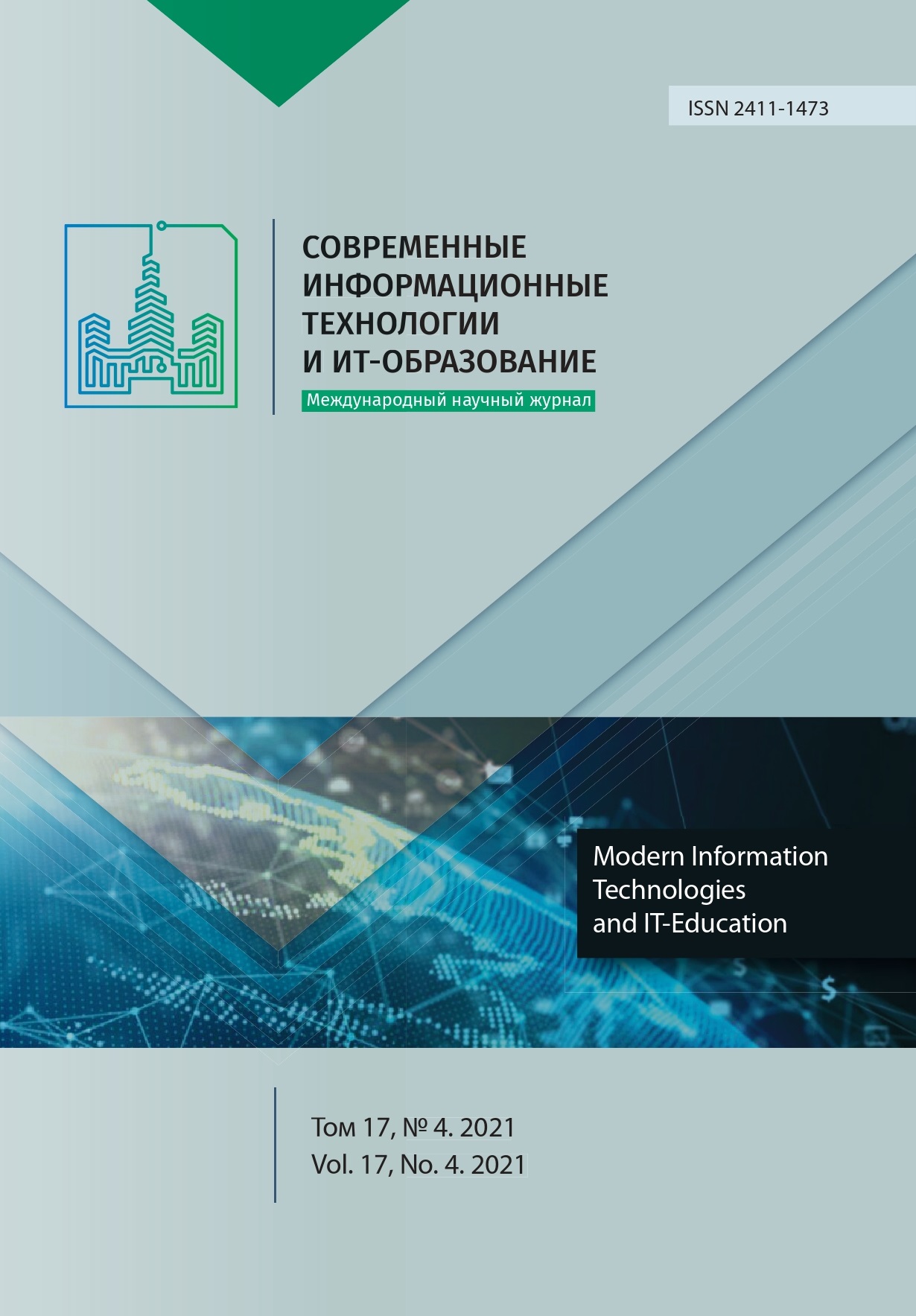Робастный дизайн модельного прогнозного управления
Аннотация
Развитие надежных систем управления связано с тем, что обычно существует источник неопределенности при моделировании системы, например возмущение, немоделированная динамика, неопределенность параметров и шум измерения. Некоторые характеристики, такие как стабильность, чувствительность и надежность, определены для оценки того, как система управления может справиться с неопределенностью. Система управления называется надежной, если стабильность поддерживается, а технические характеристики выполняются при наличии определенного диапазона неопределенности. Основная цель данной статьи - предложить достаточные критерии устойчивости и стабилизации по Ляпунову для систем LPV с вероятностной неопределенностью.
Литература
2. Fallah M.S., Long S.H., Xie W.F., Bhat R. Robust Model Predictive Control of Shimmy Vibration in Aircraft Landing Gears. Journal of Aircraft. 2008; 45(6):1872-1880. (In Eng.) doi: https://doi.org/10.2514/1.30499
3. Boyd S.P., El Ghaoui L., Feron E., Balakrishnan V. Linear Matrix Inequalities in System and Control Theory. SIAM studies in applied mathematics. Vol. 15. University City Science Center, Philadelphia, PA: SIAM; 1994. (In Eng.)
4. Baranyi P., Yam Y., Várlaki P. Tensor Product Model Transformation in Polytopic Model-Based Control. Taylor & Francis Group, LLC; 2014. 262 p. (In Eng.) doi: https://doi.org/10.1201/9781315218045
5. Wang M.H., Liu G., Hou H.Q. Polytopic Decomposition of the Linear Parameter-Varying Model Based on HOSVD. Applied Mechanics and Materials. 2012; 203:142-147. (In Eng.) doi: https://doi.org/10.4028/www.scientific.net/amm.203.142
6. Baranyi P., Yam Y., Tikk D., Patton R.J. Trade-off between approximation accuracy and complexity: TS controller design via HOSVD based complexity minimization. In: Casillas J., Cordón O., Herrera F., Magdalena L. (eds.) Interpretability Issues in Fuzzy Modeling. Studies in Fuzziness and Soft Computing. Springer, Berlin, Heidelberg. 2003; 128:249-277. (In Eng.) doi: https://doi.org/10.1007/978-3-540-37057-4_11
7. Baranyi P. TP model transformation as a way to LMI-based controller design. IEEE Transactions on Industrial Electronics. 2004; 51(2):387-400. (In Eng.) doi: https://doi.org/10.1109/TIE.2003.822037
8. Baranyi P., Varkonyi-Koczy A.R., Yam Y., Patton R.J. Adaptation of TS fuzzy models without complexity expansion: HOSVD-based approach. IEEE Transactions on Instrumentation and Measurement. 2005; 54(1):52-60. (In Eng.) doi: https://doi.org/10.1109/TIM.2004.838108
9. Kothare M.V., Balakrishnan V., Morari M. Robust constrained model predictive control using linear matrix inequalities. Automatica. 1996; 32(10):1361-1379. (In Eng.) doi: https://doi.org/10.1016/0005-1098(96)00063-5
10. Cuzzola F.A., Geromel J.C., Morari M. An improved approach for constrained robust model predictive control. Automatica. 2002; 38(7):1183-1189. (In Eng.) doi: https://doi.org/10.1016/S0005-1098(02)00012-2
11. Wada N., Saito K., Saeki M. Model predictive control for linear parameter varying systems using parameter dependent Lyapunov function. The 2004 47th Midwest Symposium on Circuits and Systems (MWSCAS '04). IEEE Press; 2004. p. iii133-iii136. (In Eng.) doi: https://doi.org/10.1109/MWSCAS.2004.1354309
12. Balandin D.V., Kogan M.M. Multicriteria Robust Generalized H2 and γ0 Controllers with Application to Stabilization of a Rotor in Electromagnetic Bearings. Automation and Remote Control. 2018; 79(6):996-1012. (In Eng.) doi: https://doi.org/10.1134/S0005117918060024
13. Balandin D.V., Kogan M.M. Synthesis of Optimal Robust H∞-Control by Convex Optimization Methods. Automation and Remote Control. 2004; 65(7):1099-1109. (In Eng.) doi: https://doi.org/10.1023/B:AURC.0000038716.40679.9b
14. Balandin D.V., Kogan M.M. An algorithm for constructing a Lyapunov function in the synthesis of dynamic regulators of given order. Differential Equations. 2004; 40(11):1533-1538. (In Eng.) doi: https://doi.org/10.1007/s10625-005-0059-8
15. Alessio A., Bemporad A. A Survey on Explicit Model Predictive Control. In: Magni L., Raimondo D.M., Allgöwer F. (eds.) Nonlinear Model Predictive Control. Lecture Notes in Control and Information Sciences. 2009; 384:345-369. Springer, Berlin, Heidelberg. (In Eng.) doi: https://doi.org/10.1007/978-3-642-01094-1_29
16. Herceg M., Kvasnica M., Fikar M. Parametric Approach to Nonlinear Model Predictive Control. In: Magni L., Raimondo D.M., Allgöwer F. (eds.) Nonlinear Model Predictive Control. Lecture Notes in Control and Information Sciences. 2009; 384:381-389. Springer, Berlin, Heidelberg. (In Eng.) doi: https://doi.org/10.1007/978-3-642-01094-1_31
17. Camacho E.F., Bordons C. Nonlinear Model Predictive Control. In: Model Predictive control. Advanced Textbooks in Control and Signal Processing. Springer, London; 2007. p. 249-288. (In Eng.) doi: https://doi.org/10.1007/978-0-85729-398-5_9
18. Garcia C.E., Prett D.M., Morari M. Model predictive control: Theory and practice – A survey. Automatica. 1989; 25(3):335-348. (In Eng.) doi: https://doi.org/10.1016/0005-1098(89)90002-2
19. Dombrovskii V.V., Obedko T.Yu., Samorodova M.V. The closed-loop optimal feedback model predictive control policy for systems with stochastic correlated parameters. Tomsk State University Journal of Control and Computer Science. 2017; (39):11-16. (In Russ., abstract in Eng.) doi: https://doi.org/10.17223/19988605/39/2
20. Balandin D.V., Kogan M.M. An optimization algorithm for checking feasibility of robust H ∞-control problem for linear time-varying uncertain systems. International Journal of Control. 2004; 77(5):498-503. (In Eng.) doi: https://doi.org/10.1080/00207170410001674028
21. Pakshin P.V. Exponential dissipativeness of the random-structure diffusion processes and problems of robust stabilization. Automation and Remote Control. 2007; 68(10):1852-1870. (In Eng.) doi: https://doi.org/10.1134/S0005117907100128
22. Ferramosca A., Limon D., Alvarado I., Alamo T., Camacho E.F. MPC for tracking with optimal closed-loop performance. Automatica. 2009; 45(8):1975-1978. (In Eng.) doi: https://doi.org/10.1016/j.automatica.2009.04.007
23. Maciejowski J. Predictive Control With Constraints. Pearson; 2001. 256 p. (In Eng.)
24. Wang Y., Boyd S. Fast Model Predictive Control Using Online Optimization. IEEE Transactions on Control Systems Technology. 2010; 18(2):267-278. (In Eng.) doi: https://doi.org/10.1109/TCST.2009.2017934
25. Wright S.J. Applying new optimization algorithms to model predictive control. Proceedings of the 5th International Conference on Chemical Process Control. aIChE Symposium Series. 1997; 93:1-10. Available at: https://pages.cs.wisc.edu/~swright/papers/P561.pdf (accessed 07.09.2021). (In Eng.)

Это произведение доступно по лицензии Creative Commons «Attribution» («Атрибуция») 4.0 Всемирная.
Редакционная политика журнала основывается на традиционных этических принципах российской научной периодики и строится с учетом этических норм работы редакторов и издателей, закрепленных в Кодексе поведения и руководящих принципах наилучшей практики для редактора журнала (Code of Conduct and Best Practice Guidelines for Journal Editors) и Кодексе поведения для издателя журнала (Code of Conduct for Journal Publishers), разработанных Комитетом по публикационной этике - Committee on Publication Ethics (COPE). В процессе издательской деятельности редколлегия журнала руководствуется международными правилами охраны авторского права, нормами действующего законодательства РФ, международными издательскими стандартами и обязательной ссылке на первоисточник.
Журнал позволяет авторам сохранять авторское право без ограничений. Журнал позволяет авторам сохранить права на публикацию без ограничений.
Издательская политика в области авторского права и архивирования определяются «зеленым цветом» в базе данных SHERPA/RoMEO.
Все статьи распространяются на условиях лицензии Creative Commons «Attribution» («Атрибуция») 4.0 Всемирная, которая позволяет другим использовать, распространять, дополнять эту работу с обязательной ссылкой на оригинальную работу и публикацию в этом журналe.













